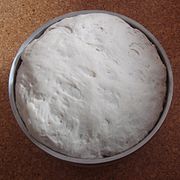Bread
 Various leavened breads | |
| Main ingredients | Flour, water |
|---|---|
Bread is a staple food prepared from a dough of flour (usually wheat) and water, usually by baking. Throughout recorded history and around the world, it has been an important part of many cultures' diet. It is one of the oldest human-made foods, having been of significance since the dawn of agriculture, and plays an essential role in both religious rituals and secular culture.
Bread may be leavened by naturally occurring microbes (e.g. sourdough), chemicals (e.g. baking soda), industrially produced yeast, or high-pressure aeration, which creates the gas bubbles that fluff up bread. In many countries, commercial bread often contains additives to improve flavor, texture, color, shelf life, nutrition, and ease of production.
Etymology
The
History
Bread is one of the oldest prepared foods. Evidence from 30,000 years ago in Europe and Australia revealed starch residue on rocks used for pounding plants.

An early
There were multiple sources of
The ancient Egyptians, Greeks, and Romans all considered the degree of refinement in the bakery arts as a sign of civilization.[9]
The
Types
Bread is the
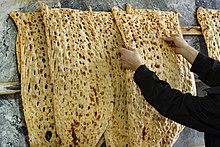

Bread is also made from the flour of other wheat species (including
Properties
Physical-chemical composition
In
Three

Acrylamide, like in other starchy foods that have been heated higher than 120 °C (248 °F), has been found in recent years to occur in bread. Acrylamide is neurotoxic, has adverse effects on male reproduction and developmental toxicity and is carcinogenic. A study has found that more than 99 percent of the acrylamide in bread is found in the crust.[28]
A study by the
Culinary uses

Bread can be served at many
Bread is used as an ingredient in other culinary preparations, such as the use of
Nutritional significance
Bread is a good source of
Crust
Bread crust is formed from surface dough during the cooking process. It is hardened and browned through the
Preparation

Doughs are usually
Methods of processing dough into bread include the straight dough process, the sourdough process, the Chorleywood bread process and the sponge and dough process.

Formulation
Professional bread recipes are stated using the baker's percentage notation. The amount of flour is denoted to be 100%, and the other ingredients are expressed as a percentage of that amount by weight. Measurement by weight is more accurate and consistent than measurement by volume, particularly for dry ingredients. The proportion of water to flour is the most important measurement in a bread recipe, as it affects texture and crumb the most. Hard wheat flours absorb about 62% water, while softer wheat flours absorb about 56%.[39] Common table breads made from these doughs result in a finely textured, light bread. Most artisan bread formulas contain anywhere from 60 to 75% water. In yeast breads, the higher water percentages result in more CO2 bubbles and a coarser bread crumb.
Dough recipes commonly call for 500 grams (about 1.1 pounds) of flour, which yields a single loaf of bread or two baguettes.
Flour
Flour is grain ground into a powder. Flour provides the primary structure, starch and protein to the final baked bread. The protein content of the flour is the best indicator of the quality of the bread dough and the finished bread. While bread can be made from all-purpose wheat flour, a specialty bread flour, containing more protein (12–14%), is recommended for high-quality bread. If one uses a flour with a lower protein content (9–11%) to produce bread, a shorter mixing time is required to develop gluten strength properly. An extended mixing time leads to oxidization of the dough, which gives the finished product a whiter crumb, instead of the cream color preferred by most artisan bakers.[40]
Wheat flour, in addition to its starch, contains three water-soluble protein groups (
Liquids
Water, or some other liquid, is used to form the flour into a paste or dough. The weight or ratio of liquid required varies between recipes, but a ratio of three parts liquid to five parts flour is common for yeast breads.[42] Recipes that use steam as the primary leavening method may have a liquid content in excess of one part liquid to one part flour. Instead of water, recipes may use liquids such as milk or other dairy products (including buttermilk or yogurt), fruit juice, or eggs. These contribute additional sweeteners, fats, or leavening components, as well as water.[43]
Fats or shortenings
Fats, such as butter, vegetable oils, lard, or that contained in eggs, affect the development of gluten in breads by coating and lubricating the individual strands of protein. They also help to hold the structure together. If too much fat is included in a bread dough, the lubrication effect causes the protein structures to divide. A fat content of approximately 3% by weight is the concentration that produces the greatest leavening action.[44] In addition to their effects on leavening, fats also serve to tenderize breads and preserve freshness.
Bread improvers
Salt
Salt (
Mixtures of salts are sometimes employed, such as employing potassium chloride to reduce the sodium level, and monosodium glutamate to give flavor (umami).
Leavening
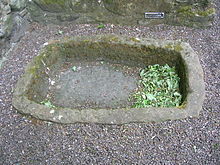
Chemicals
A simple technique for leavening bread is the use of gas-producing chemicals. There are two common methods. The first is to use
Yeast

Many breads are leavened by
The baker's yeast and sourdough methods follow the same pattern. Water is mixed with flour, salt and the leavening agent. Other additions (spices, herbs, fats, seeds, fruit, etc.) are not needed to bake bread, but are often used. The mixed dough is then allowed to rise one or more times (a longer rising time results in more flavor, so bakers often "punch down" the dough and let it rise again), loaves are formed, and (after an optional final rising time) the bread is baked in an oven.[48]
Many breads are made from a "
-
Before first rising
-
After first rising
-
After proofing, ready to bake
Sourdough
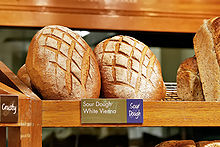
Sourdough is a type of bread produced by a long fermentation of dough using naturally occurring yeasts and lactobacilli. It usually has a mildly sour taste because of the lactic acid produced during anaerobic fermentation by the lactobacilli. Longer fermented sourdoughs can also contain acetic acid, the main non-water component of vinegar.[52][53][54]
Sourdough breads are made with a sourdough starter. The starter cultivates yeast and lactobacilli in a mixture of flour and water, making use of the microorganisms already present on flour; it does not need any added yeast. A starter may be maintained indefinitely by regular additions of flour and water. Some bakers have starters many generations old, which are said to have a special taste or texture.[52] At one time, all yeast-leavened breads were sourdoughs. Recently there has been a revival of sourdough bread in artisan bakeries.[55]
Traditionally, peasant families throughout Europe baked on a fixed schedule, perhaps once a week. The starter was saved from the previous week's dough. The starter was mixed with the new ingredients, the dough was left to rise, and then a piece of it was saved to be the starter for next week's bread.[48]
Steam
The rapid expansion of steam produced during baking leavens the bread, which is as simple as it is unpredictable. Steam-leavening is unpredictable since the steam is not produced until the bread is baked. Steam leavening happens regardless of the raising agents (baking soda, yeast, baking powder, sour dough, beaten egg white) included in the mix. The leavening agent either contains air bubbles or generates carbon dioxide. The heat vaporises the water from the inner surface of the bubbles within the dough. The steam expands and makes the bread rise. This is the main factor in the rising of bread once it has been put in the oven.[56] CO2 generation, on its own, is too small to account for the rise. Heat kills bacteria or yeast at an early stage, so the CO2 generation is stopped.
Bacteria
Salt-rising bread does not use yeast. Instead, it is leavened by Clostridium perfringens, one of the most common sources of food-borne illness.[57][58]
Aeration
The Pressure-Vacuum mixer was later developed by the Flour Milling and Baking Research Association for the Chorleywood bread process. It manipulates the gas bubble size and optionally the composition of gases in the dough via the gas applied to the headspace.[60]
Cultural Significance
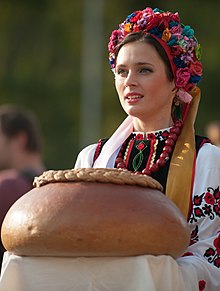
Bread has a significance beyond mere nutrition in many cultures because of its history and contemporary importance. Bread is also significant in Christianity as one of the elements (alongside wine) of the Eucharist,[61] and in other religions including Paganism.[62]
In many cultures, bread is a metaphor for basic necessities and living conditions in general. For example, a "bread-winner" is a household's main economic contributor and has little to do with actual bread-provision. This is also seen in the phrase "putting bread on the table". The Roman poet Juvenal satirized superficial politicians and the public as caring only for "panem et circenses" (bread and circuses).[63] In Russia in 1917, the Bolsheviks promised "peace, land, and bread."[64][65] The term "breadbasket" denotes an agriculturally productive region. In parts of Northern, Central, Southern and Eastern Europe bread and salt is offered as a welcome to guests.[66] In India, life's basic necessities are often referred to as "roti, kapra aur makan" (bread, cloth, and house).[67]
Words for bread, including "dough" and "bread" itself, are used in English-speaking countries as synonyms for money.[1] A remarkable or revolutionary innovation may be called the best thing since "sliced bread".[68] The expression "to break bread with someone" means "to share a meal with someone".[69] The English word "lord" comes from the Anglo-Saxon hlāfweard, meaning "bread keeper."[70]
Bread is sometimes referred to as "the staff of life", although this term can refer to other staple foods in different cultures: the Oxford English Dictionary defines it as "bread (or similar staple food)".[71][72] This is sometimes thought to be a biblical reference, but the nearest wording is in Leviticus 26 "when I have broken the staff of your bread".[73] The term has been adopted in the names of bakery firms.[74]
Fictional Breads
Lembas bread: a fictional bread from the Lord of the rings. It was given to Frodo by Galadriel and kept him alive through his journey.
Bread of the two elders: a magical type of bread from Hungarian folktales (from the Ördög és a kenyér story). It was able to talk and ward off the Ördög.[75]
See also
- Bark bread – Scandinavian bread used as famine food
- Bread bowl – Round loaf of bread which has had a large portion of the middle cut out to create an edible bowl
- Bread clip – Closure device for plastic bags
- Bread dildo – Dildo prepared using bread, allegedly made in the Greco-Roman era around 2,000 years ago
- Breading– Residue of dried bread
- Bread machine – Type of home appliance for baking bread
- Bread pan – Kitchen utensil
- Crouton – Rebaked breads
- List of breads
- List of bread dishes – Dishes using bread as a main ingredient, listed by category
- List of toast dishes
- Quick bread – Bread leavened with agents other than yeast
- Sliced bread – Loaf of bread that has been sliced with a machine
- Slow Bread – Type of bread made using very little yeast
- Sop – Piece of bread or toast that is drenched in liquid and then eaten.
- Stuffing – Edible mixture filling a food's cavity
- White bread – Type of bread made from white wheat flour
References
- ^ a b Harper, Douglas. "bread". Online Etymology Dictionary.
- ISBN 978-0-521-64398-6.
Slavic langues retain many Gothic words, reflecting cultural borrowings: thus khleb, (bread) from an earlier khleiba from Gothic hlaifs, or, rather, from the more ancient form hlaibhaz, which meant bread baked in an oven (and, probably, made with yeast), as different from a l-iepekha, which was a flat cake moulded (liepiti) from paste, and baked on charcoal. [the same nominal stem *hlaibh- has been preserved in modern English as loaf; cf. Lord, from ancient hlafweard bread-keeper]
- ^ Dean, Sam (2 August 2013). "The Etymology of the Word 'Bread'". Bon Appetit. Retrieved 30 September 2016.
- ^ "Prehistoric man ate flatbread 30,000 years ago: study". phys.org. Science X. Agence France-Presse. 19 October 2010. Retrieved 19 October 2010.
- ISSN 0261-3077. Retrieved 8 February 2020.
- ^ Briggs, Helen (17 July 2018). "Prehistoric bake-off: Scientists discover oldest evidence of bread". BBC News. Retrieved 17 July 2018.
- ^ Amaia Arranz-Otaegui, Lara Gonzalez Carretero, Monica N. Ramsey, Dorian Q. Fuller, and Tobias Richter: Archaeobotanical evidence reveals the origins of bread 14,400 years ago in northeastern Jordan. PNAS, 11 July 2018 (online Archived 19 October 2018 at the Wayback Machine)
- ISBN 978-0-684-80001-1.
- ^ a b Arzani A.: Emmer (Triticum turgidum spp. dicoccum) flour and breads. In Preedy V.R., Watson R.R., Patel V.B. (Eds. 2011), Flour and Breads and their Fortification in Health and Disease Prevention, Academic Press, California, pp. 69-78.
- ISBN 978-0-8128-1437-8.
- ^ Pliny the Elder (1938). Natural History. Loeb Classics. p. 1.255.
Generally however they do not heat it up at all, but only use the dough kept over from the day before; manifestly it is natural for sourness to make the dough ferment
- ^ Chorleywood Industrial Bread Making Process. allotment.org.uk
- ^ bbc.com: "Chorleywood: The bread that changed Britain" Archived 13 June 2018 at the Wayback Machine, 7 June 2011
- ^ "fob.co.uk: "History of bread – 20th century"". Archived from the original on 19 April 2019. Retrieved 14 May 2018.
- PMID 35889135.
- ^ Peña, R. J. "Wheat for bread and other foods". Food and Agriculture Organization. Retrieved 1 October 2016.
Wheat, in the form of bread, provides more nutrients to the world population than any other single food source.
- ^ "Wheat". Grains & Legumes Nutrition Council. Archived from the original on 5 October 2016. Retrieved 1 October 2016.
Aside from bread wheat and durum, other types of wheat include spelt, emmer, einkorn and kamut. These wheat varieties are commonly referred to as 'ancient' grains and are increasingly being used in the manufacture of niche wheat-based food products.
- ISBN 978-3-319-14687-4.
In the past, maize (corn), barley, oats, sorghum, millet and rice have all found their way into bread products at some time, usually when wheat and rye have been in short supply.
- PMID 24481131.
- diagnosis, according to the previously mentioned work-up, patients are advized to start with a GFD [49]. (...) NCGS patients can experience more symptoms than CD patients following a short gluten challenge [77]. (NCGS=non-celiac gluten sensitivity; CD=coeliac disease; GFD=gluten-free diet)
- gluten ataxia is lifelong adherence to a GFD.
- S2CID 9970042.and coeliac disease the dietary avoidance of wheat and other gluten-containing cereals is the only effective treatment.
For both wheat allergy
- .
- S2CID 85239461.
- PMID 26047292.
- ^ PMID 17008153.
- ^ McGee, Harold (2004). On Food and Cooking: The Science and Lore of the Kitchen. New York: Scribner. pp. 515–80.
- PMID 15053550.
- ^ "Lange Teigführung ? Besser verträgliches Brot". dhz.net (in German). 6 September 2016. Retrieved 16 June 2022.
- doi:10.1016/j.jff.2016.05.019, retrieved 16 June 2022)
{{citation}}: CS1 maint: multiple names: authors list (link - ^ Grotts, Lisa Mirza (21 June 2011). "Bread and Butter Etiquette". Huffington Post. Retrieved 2 October 2016.
- ^ "Sandwich Recipes". Simply Recipes. Archived from the original on 30 September 2016. Retrieved 2 October 2016.
- ^ "Our 10 best bread recipes". The Guardian. 6 September 2014. Retrieved 2 October 2016.
Our most dutiful mealtime companion becomes the main ingredient in this inventive array of recipes, from a hearty clam chowder to a luxurious take on a pudding favourite...
- ^ Dietary Guidelines for Americans 2010 Archived 1 September 2016 at the Wayback Machine. U.S. Department of Agriculture, U.S. Department of Health and Human Services
- PMID 27610232.
- ISBN 978-1-921966-73-6p. 156
- ^ Winkler, Sarah (29 July 2009). "Discovery Health "Is eating bread crust really good for you?"". Health.howstuffworks.com. Archived from the original on 24 October 2012. Retrieved 26 October 2012.
- British Broadcasting Corporation. Archived from the originalon 24 September 2016. Retrieved 2 October 2016.
- ISBN 978-0-8247-7984-9.
- ISBN 978-0-471-16857-7.
A high gluten white flour will require more mix time than a white flour with a lower gluten content,...
- ISBN 978-1-84480-706-2.
- ^ Hydration ratio for breads Archived 14 January 2013 at the Wayback Machine. Food.laurieashton.com (5 June 2009). Retrieved 21 March 2013.
- ^ "Yeast & Baking Lessongs. Liquids". Red Star Yeast. Retrieved 2 October 2016.
- ISBN 978-0-387-38563-1.
- ^ Tenbergen, Klaus (1999). "Dough and Bread Conditioners". Food and Product Design Magazine. Retrieved 2 October 2016.
- ISBN 0-679-40907-6
- ISBN 1-58008-268-8
- ^ a b c d e f "The Bread Leavening Process". Becoming a Chef. 15 August 2016. Retrieved 2 October 2016.
- ISBN 978-0-387-38563-1.
- ^ "Artisan bread baking tips: Poolish & biga". Weekend Bakery. Retrieved 2 October 2016.
- ^ "Preferments". King Arthur Flour.
{{cite web}}: Missing or empty|url=(help) - ^ ISBN 978-0-19-211579-9.
- ISBN 978-1-4899-9189-8.
- PMID 5042265.
- ^ Mesure, Susie (30 January 2016). "Supermarkets cash in on sourdough bread craze as popularity surges". The Independent. Retrieved 2 October 2016.
- ISBN 978-0-85404-486-3. Retrieved 8 December 2012.
When bread expands in the oven the resulting expansion is known as oven spring. It has been calculated that water expansion was responsible for some 60% of the expansion.
- ^ "Susan R. Brown's Salt Rising Bread Project". Home.comcast.net. Archived from the original on 30 June 2012. Retrieved 3 June 2010.
- PMID 18646681.
- ^ Richardson MD FRS, Benjanmin Ward. On the Healthy Manufacture of Bread: A Memoir on the System of Dr. Dauglish. Baillière, Tindall, & Cox, 1884. pp. 18, 20–21, 34, 62–63, 67–70, 74.
- ISBN 978-1-85573-724-2.
- ^ "Eucharist (Christianity) – Encyclopædia Britannica". Archived from the original on 19 May 2008. Retrieved 2 June 2022.
- ISBN 978-1-56414-884-1.
- ^ Juvenal's literary and cultural influence (Book IV: Satire 10.81)
- ^ "Russia". Encyclopædia Britannica. Retrieved 3 June 2010.
- ^ "Vladimir Lenin: From March to October. SparkNotes". Sparknotes.com. Retrieved 3 June 2010.
- ISBN 9781787134782. Retrieved 25 January 2021.
- ISBN 978-1-4828-1563-4.
- ^ Molella, Art (8 February 2012). "How the Phrase 'The Best Thing Since Sliced Bread' Originated". The Atlantic. Retrieved 30 September 2016.
- ^ "Break bread with". The Free Dictionary. Retrieved 1 January 2017.
- ^ "Lord". Merriam-Webster. Retrieved 1 January 2017.
- ^ "The staff of life". Cambridge Dictionary. Retrieved 20 April 2018.
- ^ "Staff". Oxford English Dictionary (Online ed.). Oxford University Press. (Subscription or participating institution membership required.) OED cites 1638 "Bread is worth all, being the Staffe of life" but also 1901 "Broad beans form one of the staves of life in Sicily".
- ^ "Leviticus 26:26". Bible Study Tools. Retrieved 20 April 2018.
- ^ "Home page". Staff of Life Bakery. Archived from the original on 20 April 2018. Retrieved 20 April 2018. An example
- ^ "A kicsi dió". www.nepmese.hu (in Hungarian). Retrieved 21 April 2024.
Further reading
- Kaplan, Steven Laurence: Good Bread Is Back: A Contemporary History of French Bread, the Way It Is Made, and the People Who Make It. Durham/ London: Duke University Press, 2006. ISBN 978-0-8223-3833-8
- Jacob, Heinrich Eduard: Six Thousand Years of Bread: Its Holy and Unholy History. Garden City / New York: Doubleday, Doran and Comp., 1944. New 1997: New York: Lyons & Burford, Publishers (Foreword by Lynn Alley), ISBN 1-55821-575-1<
- Spiekermann, Uwe: "Brown Bread for Victory: German and British Wholemeal Politics in the Inter-War Period", in: Trentmann, Frank and Just, Flemming (ed.): Food and Conflict in Europe in the Age of the Two World Wars. Basingstoke / New York: Palgrave, 2006, pp. 143–71, ISBN 1-4039-8684-3
- Cunningham, Marion (1990). The Fannie Farmer cookbook. illustrated by Lauren Jarrett (13th ed.). New York: Alfred A. Knopf. ISBN 978-0-394-56788-4.
- Trager, James (1995). The food chronology: a food lover's compendium of events and anecdotes from prehistory to the present. Henry Holt. ISBN 978-0-8050-3389-2.
- Davidson, Alan (1999). The Oxford Companion to Food. Oxford University Press. ISBN 978-0-19-211579-9.
- D. Samuel (2000). "Brewing and baking". In P. T. Nicholson; I. Shaw (eds.). Ancient Egyptian materials and technology. Cambridge: Cambridge University Press. pp. 537–76. ISBN 0-521-45257-0.
- Pyler, E. J. (1988). Baking Science & Technology 3rd Ed. vols. I & II. Sosland Publishing Company. ISBN 978-1-882005-02-4.
External links
 Bread and confectionery travel guide from Wikivoyage
Bread and confectionery travel guide from Wikivoyage





